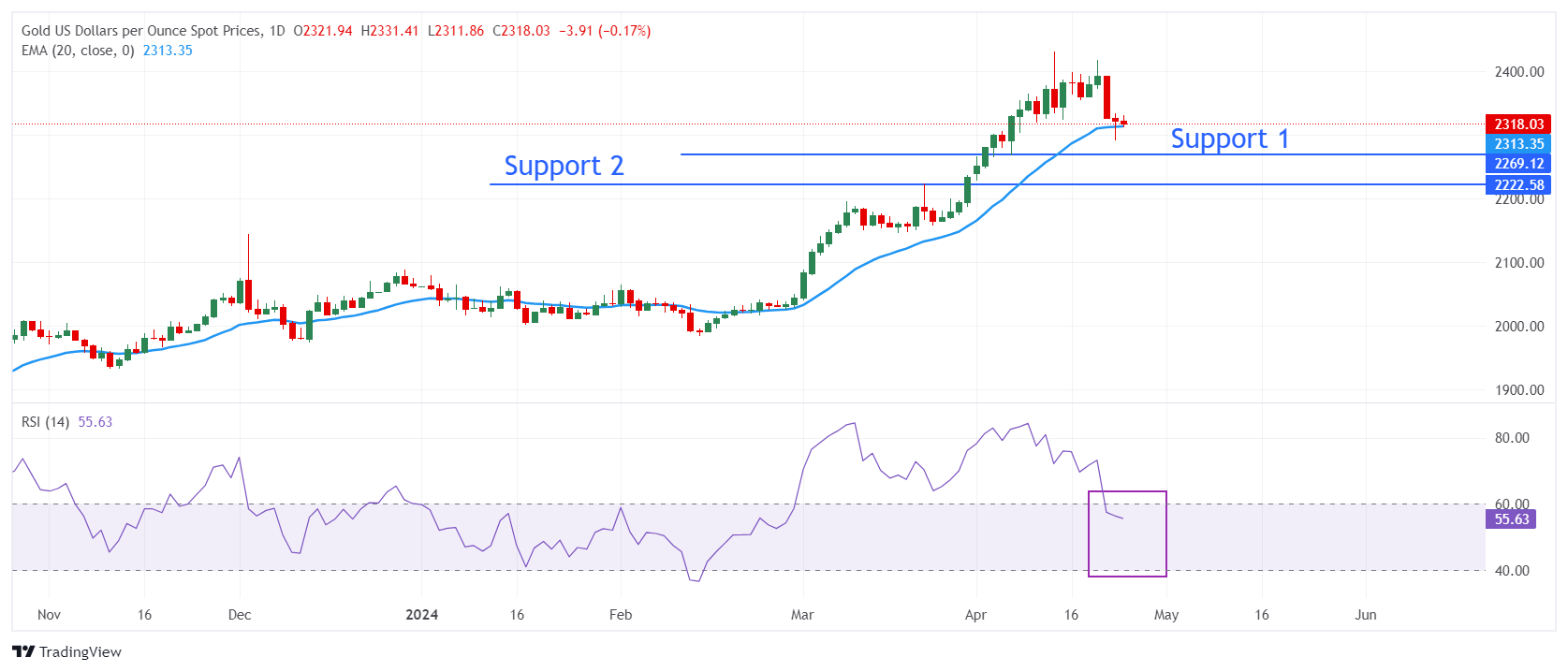- The price of Gold continues to decline in a climate of caution after the core PCE figures from the United States.
- The US dollar undergoes a correction as weak April PMI undermines investor confidence in the strong US economic outlook.
The price of Gold (XAU/USD) retreats to $2,315 in the early stages of the US session on Wednesday, as it attempts to extend its recovery above $2,320. The precious metal's near-term appeal remains weak as safe-haven demand wanes amid easing tensions in the Middle East. Additionally, investors are cautious about bullion pending the release of US first-quarter Gross Domestic Product (GDP) and underlying March Personal Consumption Expenditure Price Index (PCE) data, which They will be published on Thursday and Friday, respectively.
First quarter GDP and core inflation will provide new clues as to when the Federal Reserve (Fed) will begin reducing interest rates. It is estimated that the underlying inflation of PCE US inflation, the Fed's preferred inflation indicator, has grown 0.3%, with annual figures softening to 2.6% from 2.8% in February. The price of Gold could suffer a sharp sell-off if underlying inflation data turns out to be more bullish than expected.
US inflation indicators, such as the Consumer Price Index (CPI) and wage growth, have remained high in the first quarter. Further signs of persistent price pressures would allow the Fed to continue its argument for keeping interest rates at current levels for longer. Historically, this scenario bodes well for the US dollar and bond yields, and makes Gold less attractive.
Daily Market Moves Summary: Gold Price Remains Weak Amid Multiple Headwinds
- The price of Gold continues to decline, as safe haven demand has decreased after investors shrugged off Middle East fears in the absence of a new escalation of tensions between Iran and Israel.
- The precious metal gained some relief after plunging to $2,300 as the US Dollar weakened following the release of S&P Global's weak preliminary PMI data for April. The report showed that, surprisingly, both the manufacturing and services PMI fell from previous readings. The manufacturing PMI even fell below the 50.0 threshold, a sign of contraction.
- The agency's US economic outlook was slightly gloomy, indicating the consequences of higher interest rates from the Federal Reserve. Chris Williamson, chief economist at S&P Global Market Intelligence, said: “The US economic recovery lost momentum early in the second quarter, with flash PMI respondents reporting below-trend business activity growth in April. .More pace may be lost in the coming months, as new business entries fell in April for the first time in six months and companies' expectations for future output fell to five-month lows amid heightened concern. for the perspectives.”
- However, the near-term outlook for Gold is bearish as Fed policymakers view the current monetary policy framework as adequate due to strong demand for labor and persistent price pressures. The price of Gold could turn sideways as investors focus on US Core PCE Price Index data for March, which will influence speculation on when the Fed will pivot towards interest rate cuts. Traders currently expect the Fed to begin cutting interest rates as early as the September meeting.
- On the other hand, the US Census Bureau has published an optimistic data on durable goods orders in March, which increased 2.6% compared to 0.7% in February, after a downward revision of 1.4%. Durable goods are those with a long useful life and are a leading indicator of the underlying CPI, as it excludes the prices of non-durable goods, such as food and energy. Rising orders for durable goods indicate strong demand from households, allowing factories to raise their factory-gate prices.
Technical Analysis: Gold Price Looks Vulnerable Near $2,300

The price of Gold is struggling to establish itself near $2,300. The precious metal remains in suspense after falling near the 20-day exponential moving average (EMA), which is trading around $2,313. The yellow metal could fall to a three-week low near $2,265 amid multiple headwinds. A downside break of the three-week low of $2,265 would expose the March 21 high of $2,223.
The 14-period RSI falls below 60.00, suggesting that the bullish momentum has ended. However, the bullish bias remains intact until it sustains above 40.00.
Frequently asked questions about the Fed
What does the Federal Reserve do and how does it affect the dollar?
The monetary policy of the United States is directed by the Federal Reserve (Fed). The Fed has two mandates: achieving price stability and promoting full employment. Your main tool to achieve these objectives is to adjust interest rates.
When prices rise too quickly and inflation exceeds the Federal Reserve's 2% target, it raises interest rates, raising borrowing costs throughout the economy. This translates into a strengthening of the US Dollar (USD), as it makes the United States a more attractive place for international investors to place their money.
When inflation falls below 2% or the unemployment rate is too high, the Federal Reserve can lower interest rates to encourage borrowing, which weighs on the greenback.
How often does the Federal Reserve hold monetary policy meetings?
The Federal Reserve (Fed) holds eight meetings a year, in which the Federal Open Market Committee (FOMC) evaluates the economic situation and makes monetary policy decisions.
The FOMC is made up of twelve Federal Reserve officials: the seven members of the Board of Governors, the president of the Federal Reserve Bank of New York, and four of the eleven presidents of the regional Reserve banks, who serve for one year on a rotating basis.
What is Quantitative Easing (QE) and how does it affect the USD?
In extreme situations, the Federal Reserve can resort to a policy called Quantitative Easing (QE). QE is the process by which the Fed substantially increases the flow of credit into a clogged financial system.
It is a non-standard policy measure used during crises or when inflation is extremely low. It was the Fed's weapon of choice during the Great Financial Crisis of 2008. It involves the Fed printing more dollars and using them to buy high-quality bonds from financial institutions. QE usually weakens the US dollar.
What is Quantitative Tightening (QT) and how does it affect the US Dollar?
Quantitative tightening (QT) is the reverse process of QE, whereby the Federal Reserve stops buying bonds from financial institutions and does not reinvest the capital of the maturing bonds it has in its portfolio to buy new bonds. It is usually positive for the value of the US Dollar.
Source: Fx Street
I am Joshua Winder, a senior-level journalist and editor at World Stock Market. I specialize in covering news related to the stock market and economic trends. With more than 8 years of experience in this field, I have become an expert in financial reporting.






